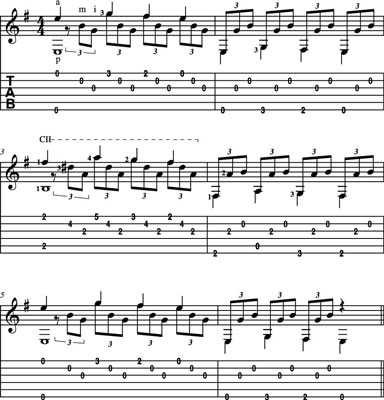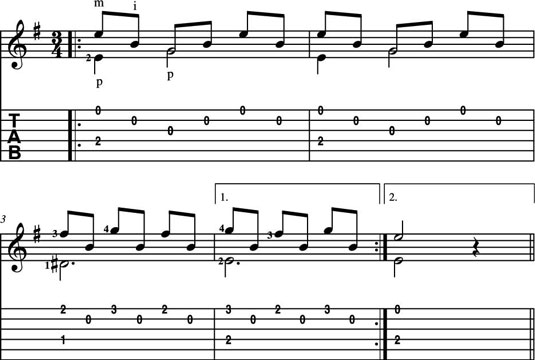Not all arpeggiated passages are straightforward — where the melody occurs consistently in either the treble or bass part on the classical guitar. In some cases the melody moves back and forth between the treble and bass, and in others the treble and bass parts contain melodic motion simultaneously.
Fortunately, the playing of such pieces requires no new techniques, but it does require a heightened awareness (on your part) of where the melody is and how to bring it out.
Playing a shifting treble-and-bass melody within arpeggios
In this example, from measure to measure, the melody alternates between the treble and bass. In the odd-numbered measures, which have the melody in the treble, bring out the melody (the upstemmed notes) with rest strokes. For the even-numbered measures, which have the melody in the bass, bring out the melody (the downstemmed notes) by giving the first note of each triplet a little more oomph than the other notes.

Note that the melody note that occurs on the third beat of each measure is a dissonance (that is, it’s not a member of the chord being arpeggiated), but that it passes smoothly from one chord tone to another.
For example, in measure 1, in which an E minor chord (made up of the notes E, G, and B) is arpeggiated, the F♯ on beat 3 functions as a passing tone (a dissonance that, in stepwise motion, passes between, and thus fills the gap between, two chord tones — in this case, G and E).
Also note, as a point of interest, that each bass melody is a repetition, but two octaves lower, of the treble melody that precedes it. Repetition imparts structural unity and thus a sense of balance to a composition.
Practicing making a shifting melody stand out
Here is an excerpt from a waltz from the guitar method of early 19th-century Italian guitar composer and virtuoso Ferdinando Carulli. A glance at the music reveals that the melody begins in the bass (measures 1 and 2) and moves to the treble (measures 3 through 5).
In measures 3 and 4, note that in the written notation, for the sake of simplicity, the composer combined the melody (the upstemmed notes on the beats: F♯-G-F♯, G-F♯-G) and the accompaniment notes (the open B’s) into a single voice. What you need to realize is that although the melody notes are written as eighths, you render them in performance as quarters.
Above, you play a dissonance known as a passing tone. Here, Waltz in E Minor presents another type of dissonance: the neighboring tone. A neighboring tone is a non-chord tone that, in stepwise motion, follows a chord tone and then returns to it (the word neighboring comes from the idea that, being just one step away from the chord tone, the dissonant note is like the chord tone’s next-door neighbor).
For example, in measure 3 you arpeggiate a B chord (B-D♯-F♯), and the G on beat 2 follows and then returns to the chord tone F♯. Because G is above F♯ in the scale, it’s called, specifically, an upper neighbor. In the following measure you arpeggiate an E minor chord (E-G-B), and the F♯ on beat 2 (following and then returning to G) is a lower neighbor.


